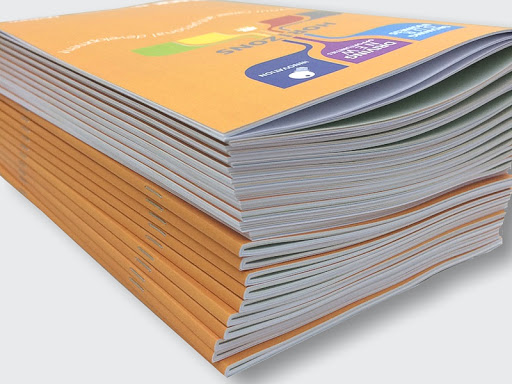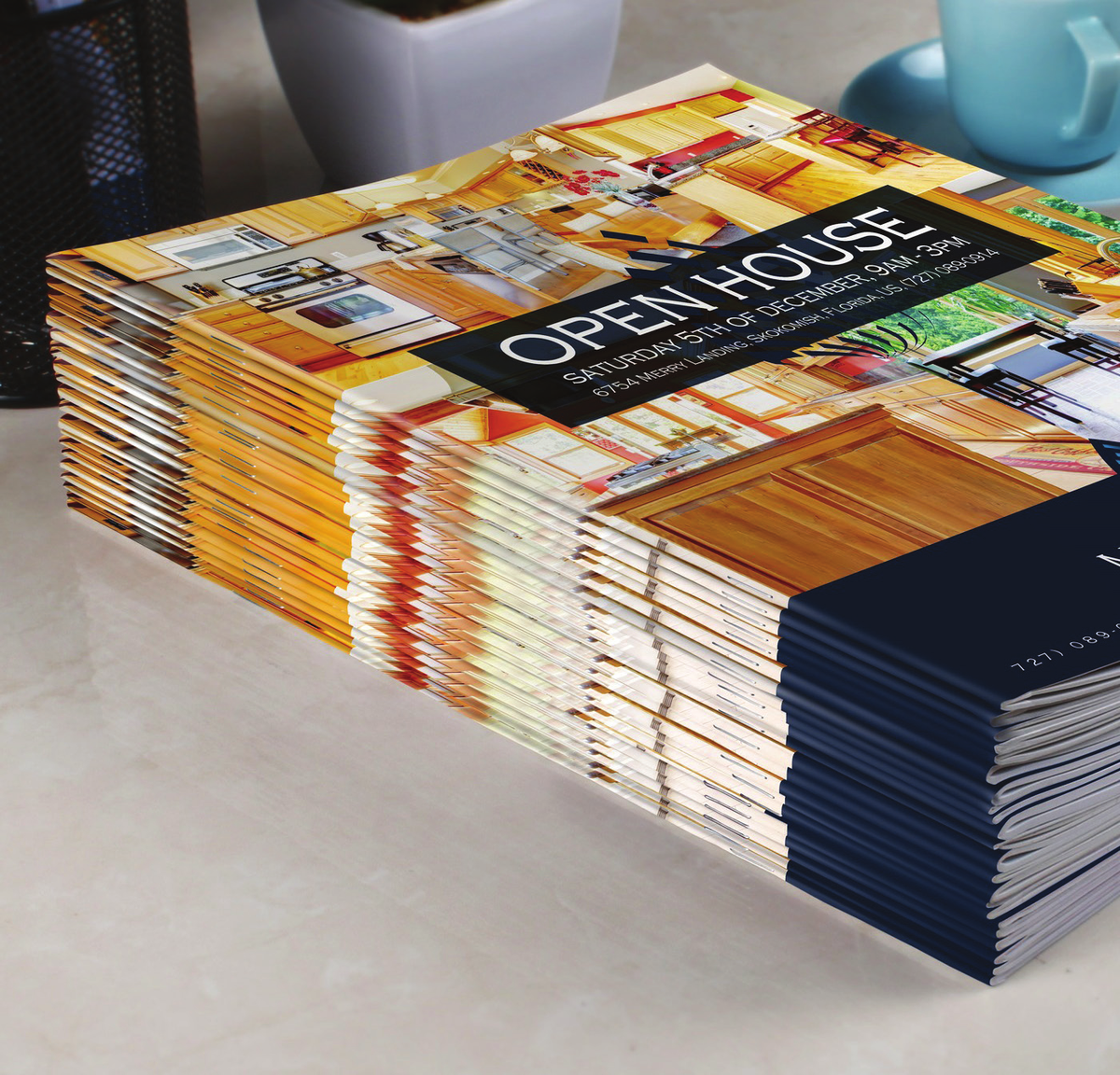The Necessary Overview to Comprehending Booklet Printing Options and Techniques
The procedure of pamphlet printing includes multiple considerations that can substantially influence the end product. From picking the ideal style and size to understanding the subtleties of binding techniques, each choice plays an essential duty. Furthermore, elements such as paper supply and printing methods further influence the performance of the brochure. As one navigates these alternatives, it ends up being crucial to understand how they adjoin and what that implies for the total result.
Understanding Brochure Formats and Dimensions
When considering pamphlet printing, comprehending the numerous styles and dimensions available is crucial for accomplishing the wanted presentation. Pamphlets can be produced in countless layouts, including saddle-stitched, spiral-bound, and perfect-bound, each offering distinctive advantages. Typical dimensions range from typical letter (8.5 x 11 inches) to smaller alternatives like A5 (5.8 x 8.3 inches), allowing for versatility based upon content and target audience.Selecting the proper dimension can influence both the format and visitor involvement. Larger sizes could suit visually driven material, while smaller sized formats may be extra easy to use and mobile. In addition, the number of pages impacts the selection of binding method, as thicker booklets may need tougher bindings. Ultimately, comprehending these elements enables an extra tailored method, making sure that the end product straightens with the intended message and aesthetic, enhancing the general efficiency of the interaction.
Picking the Right Paper Supply

Binding Approaches: Alternatives and Factors To Consider
When it pertains to binding approaches for booklets, a number of alternatives are readily available, each with distinct advantages. Saddle stitch binding uses a cost-effective service for thinner brochures, while best binding strategies provide a more refined search for thicker magazines. Wire-O binding attracts attention for its resilience and simplicity of use, making it suitable for records that call for adaptability.
Saddle Stitch Binding
Saddle stitch binding offers a useful and affordable remedy for constructing pamphlets, making it a preferred selection amongst authors and organizations. This binding technique includes folding sheets of paper in half and stapling them along the fold line, producing a neat and organized look. Commonly ideal for pamphlets with a reduced page count, saddle sewing is suitable for publications, pamphlets, and training materials. The simpleness of this strategy permits for fast production and is frequently favored for promotional things or brief runs. It is important to keep in mind that saddle stitch binding might not be suitable for thicker booklets, as the spinal column might not hold up under raised weight. In general, it stays a dependable choice for numerous printing tasks.
Perfect Binding Methods
Perfect binding is a widely made use of technique that gives a specialist and polished coating to publications and pamphlets. This method entails gluing the pages with each other at the spinal column making use of a strong adhesive, enabling a clean side and the ability to hold a larger variety of pages contrasted to saddle sewing. Perfect binding is especially ideal for thicker booklets, such as brochures and yearly reports, where a tough, flat spinal column is wanted. Additionally, it uses the option for a printed cover that can be made to enhance aesthetic appeal. Considerations such as page count, paper weight, and the intended usage of the booklet must be taken right into account, as they can affect sturdiness and total top quality.
Wire-O Binding Options
Wire-O binding, known for its sturdiness and adaptability, supplies an excellent option for brochures that need simple web page transforming and an expert look. This binding approach uses a collection of steel loopholes that hold web pages safely, enabling them to exist level when open. It is especially appropriate for brochures, manuals, and presentations as a result of its durable nature. Wire-O binding is readily available in different colors and diameters, accommodating various web page counts and thicknesses. In addition, it allows the addition of covers and tabs, enhancing the pamphlet's total visual. Considerations for Wire-O binding include the selection of cable color, the dimension of the loopholes, and the degree of customization desired, every one of which can exceptionally influence the end product's look and capability.
Digital vs. Offset Printing: Which Is Best for You?
When choosing a printing method for brochures, recognizing the distinctions between electronic and balance out printing is important. Digital printing utilizes modern-day technology to generate top notch prints rapidly and cost effectively, making it suitable for short runs or tasks calling for quick turn-around times. It allows for customization, giving the capability to publish on-demand with very little waste.In contrast, balance out printing is a traditional approach that masters generating large amounts with consistent top quality. It involves moving ink from a plate to a rubber blanket, then to the paper, which causes dynamic shades and accurate information. Counter printing generally needs longer arrangement times and is more economical for bigger volumes.Ultimately, the selection between digital and balance out printing depends on job needs, spending plan, and desired quantity. For little, time-sensitive jobs, electronic could be the very best choice, while offset may be more effective for bigger, high-quality productions.

Designing Your Booklet: Tips and Best Practices
When designing a pamphlet, mindful focus to design, font style selection, and color usage can considerably enhance its efficiency. A well-structured design guides the viewers's find this eye, while ideal font styles ensure readability and convey the wanted tone. Furthermore, efficient use of shade can evoke emotions and emphasize crucial details, making the overall style much more impactful.
Picking the Right Format
Exactly how can one efficiently pick the appropriate design for a booklet? Initially, it is important to assess the pamphlet's function and target audience. A clean, arranged layout boosts readability and interaction. Making use of a grid system can help in aligning components regularly, developing an expert look. Additionally, including visual power structure through differing dimensions and placements of photos and text can assist the reader's eye and highlight vital info. It is additionally vital to leave adequate white room, which avoids congestion and enables much better emphasis. Finally, checking various layouts with mock-ups can give insight into exactly how the layout carries out in real-world situations, making certain that the end product satisfies both practical and visual needs.
Selecting Proper Font Styles
An appropriate typeface can substantially enhance the overall design of a booklet, complementing the layout and strengthening the content's message. The choice of font styles must take into consideration readability, specifically for body message, as it assures the details comes to all viewers. Sans-serif typefaces are often preferred for digital layouts, while serif typefaces can offer a typical feeling in published materials. It's recommended to limit font choices to 2 or 3 to preserve visual coherence. Additionally, typeface dimension plays a crucial function; headings ought to be not overwhelming but distinctive, while body message ought to be comfortable for analysis. When picking font styles, alignment with the booklet's motif and target audience is important for effective interaction and aesthetic appeal.
Reliable Use of Color
Shade works as an effective device in booklet layout, leading and shaping assumptions visitor feelings. It can evoke sensations of calmness, count on, or exhilaration, depending upon the colors selected. Designers must consider shade concept principles, making sure this content that the picked palette lines up with the pamphlet's message and target market. For instance, utilizing cozy shades like red and orange can create urgency, while cooler tones like blue and environment-friendly foster tranquility.Additionally, contrast plays an essential duty; complementary colors can improve readability and aesthetic allure. Uniformity in shade use throughout web pages better strengthens brand identity and cohesion. Ultimately, effective color implementation not only captures attention but also reinforces the booklet's purpose, making it an important aspect of successful design.
Finishing Touches: Coatings and Special Results
While several take into consideration the web content and format of a brochure one of the most important aspects, the completing touches, such as finishings and special effects, play an essential duty in boosting its general charm. Coatings can offer protection and durability, making certain that the pamphlet stands up to deterioration. Matte finishes supply an innovative, non-reflective surface, while glossy layers can make shades appear even more appealing and dynamic. Unique impacts, like embossing or foil marking, add a responsive measurement that can create a remarkable perception. These techniques can highlight details areas, accentuating vital details or developing visual interest. In addition, UV finishing can provide a high-shine surface that elevates the general look.Together, these finishing touches not just boost the brochure's visual however additionally interact professionalism and interest to detail, eventually leaving a lasting influence on the reader.
Expense Factors To Consider for Brochure Printing
Recognizing the different price considerations for brochure printing is essential for organizations and services intending to optimize their budget plans. Trick factors influencing prices consist of the choice of paper, binding, and ink techniques. Better materials, such as superior paper or specialized inks, commonly increase the overall cost. In addition, the dimension and web page count of the booklet play a considerable function; bigger pamphlets call for even more resources and time to produce.Another important consideration is the printing method, whether digital or balanced out, as each has its very own rates structure and suitability for different quantities. Companies ought to likewise consider style expenses, which can differ based on complexity and making use of expert solutions. Eventually, shipping and handling charges can include in the overall, particularly for big orders. By assessing these aspects, organizations can make educated decisions that align with their financial capabilities while achieving the wanted top quality in their published products.
Often Asked Concerns
What Are the Environmental Impacts of Pamphlet Printing?
The ecological effects of brochure printing include deforestation from paper manufacturing, carbon discharges from transportation, and waste generation from thrown out products - Booklet Printing. Sustainable practices, such as using recycled paper and eco-friendly inks, can minimize these impacts
Exactly How Can I Guarantee Shade Precision in My Brochure?
To guarantee shade accuracy in a booklet, one need to use adjusted screens, employ specialist shade profiles, perform test prints, and select high-quality printing solutions that provide shade matching and proofing alternatives for best outcomes.
What Is the Normal Turnaround Time for Pamphlet Printing?
The common turn-around time for brochure printing differs depending upon the complexity and amount - Booklet Printing. Generally, it varies from a few days to 2 weeks, influenced by variables such as printing approaches and finishing needs
Are There Minimum Order Quantities for Pamphlet Printing?

Can I Publish Pamphlets in Multiple Languages?
Printing brochures in several languages is feasible. Several printing services offer choices for multilingual or multilingual formats, permitting efficient communication. Careful planning guarantees that develop aspects suit numerous languages without endangering readability or aesthetics. Additionally, elements such as paper stock and printing techniques further influence the effectiveness of the booklet. When considering booklet printing, understanding the various formats and sizes readily available is crucial for attaining the wanted discussion. When choosing a printing technique for brochures, understanding the differences in between electronic and balance out printing is necessary. Additionally, the size and web page matter of the brochure play a considerable role; bigger pamphlets need more resources and time to produce.Another vital factor to consider is the printing method, whether digital or offset, as each has its very own prices structure and viability for various quantities. Check Out Your URL The ecological effects of brochure printing include logging from paper production, carbon emissions from transport, and waste generation from thrown out materials.